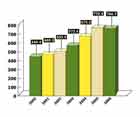STRATEGIC SOLUTIONS: Construction Review
The
residential construction recession and the outlook for adhesives in
construction.

 The U.S. housing
market enjoyed an unprecedented expansion in 2000-2005. More than 8.6 million
new single-family houses were constructed, and the value of all private
residential construction over that time period was $4.3 trillion, according to
government census data. Residential construction and expanding rehab and
remodeling markets helped push the total market size for adhesives used in
residential and commercial construction to more than $1.6 billion in 2006.
However, recent pressure on the housing market has caused a dramatic downturn
in the residential-construction industry, which could threaten adhesive growth.
The U.S. housing
market enjoyed an unprecedented expansion in 2000-2005. More than 8.6 million
new single-family houses were constructed, and the value of all private
residential construction over that time period was $4.3 trillion, according to
government census data. Residential construction and expanding rehab and
remodeling markets helped push the total market size for adhesives used in
residential and commercial construction to more than $1.6 billion in 2006.
However, recent pressure on the housing market has caused a dramatic downturn
in the residential-construction industry, which could threaten adhesive growth.
The current slump in the residential-construction market and uncertainty as to how deep the problems will have an impact on the adhesive manufacturing industry. The residential and commercial construction markets make up about a fifth of adhesive end uses in the United States. With troubling headlines on subprime lending, housing starts, existing home sales and falling home prices, which factors are the most important to consider when forecasting future growth trends for housing and adhesive usage in home construction?
Arguments for a sustained recession in residential construction include the following.
As far as what will signal a turnaround in the current residential housing recession, follow the number of new-home sales, not existing-home sales. Both of these statistics receive a lot of press coverage, but the new-home sales statistic is most relevant to industry participants. New construction is a significant component in the calculation of GDP, while the turnover of the existing supply of homes does not have any effect on GDP. During the most recent housing boom, new residential investment reached a peak of 6.5% of GDP in the second half of 2005, well above the 4.5% of GDP average of the last 35 years.
Given the current outlook, we estimate that total adhesive use in the construction sector will grow at an average annual rate of 3.2% from 2006 to 2010 in North America. Primary reasons for this growth include the following.
For more information, phone (513) 469-7555 or visit www.chemquest.com.


Table. Private Residential Investment (Source: U.S. Dept. of Commerce).
The current slump in the residential-construction market and uncertainty as to how deep the problems will have an impact on the adhesive manufacturing industry. The residential and commercial construction markets make up about a fifth of adhesive end uses in the United States. With troubling headlines on subprime lending, housing starts, existing home sales and falling home prices, which factors are the most important to consider when forecasting future growth trends for housing and adhesive usage in home construction?
Arguments for a sustained recession in residential construction include the following.
- Subprime defaults will spread to Alt-A (between prime and sub-prime) loans, and potential homebuyers may no longer qualify for loans as lenders scale back credit.
- A glut of new-housing inventory will continue to put downward pressure on home prices for the next couple of years.
- Between 2000 and 2005, housing prices rose dramatically and disconnected from wage growth. Prices will need to fall a great deal more in order to bring the market back into equilibrium with wages.
- Ninety percent of homeowners have 20+% equity in their houses. This dampens the downside, as potential sellers often stay put during such downturns rather then sell for less than their home’s perceived value.
- Growth in the number of households will create demand for new homes.
As far as what will signal a turnaround in the current residential housing recession, follow the number of new-home sales, not existing-home sales. Both of these statistics receive a lot of press coverage, but the new-home sales statistic is most relevant to industry participants. New construction is a significant component in the calculation of GDP, while the turnover of the existing supply of homes does not have any effect on GDP. During the most recent housing boom, new residential investment reached a peak of 6.5% of GDP in the second half of 2005, well above the 4.5% of GDP average of the last 35 years.
Given the current outlook, we estimate that total adhesive use in the construction sector will grow at an average annual rate of 3.2% from 2006 to 2010 in North America. Primary reasons for this growth include the following.
- Newly built houses continue to expand in size. The median square footage for single-family houses rose from 1,535 sq ft. in 1975 to 2,227 sq ft. in 2005.
- Increases in the number of bathrooms, garages and finished basements, as well as interior and exterior decorative moldings in new houses.
- The continued use of adhesives for all facets of construction: decks, header boards, staircases, underlayments and various finished carpentry.
- Adhesives continue to displace mechanical fasteners and as a way to contain the rising cost of building materials and labor, both on-site and through increased use of prefabricated components during construction.
- Increased use of prefabricated components during construction also tends to favor the increased use of adhesives, because adhesives help maintain the rigidity of the component structure during shipping. This has been demonstrated repeatedly in the manufactured housing segment.
For more information, phone (513) 469-7555 or visit www.chemquest.com.
Links
Looking for a reprint of this article?
From high-res PDFs to custom plaques, order your copy today!





